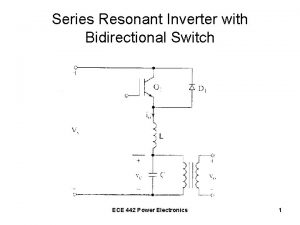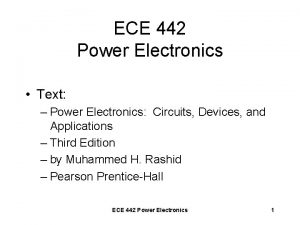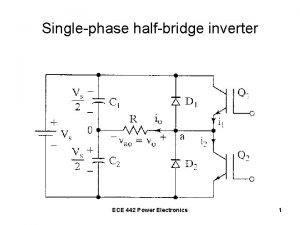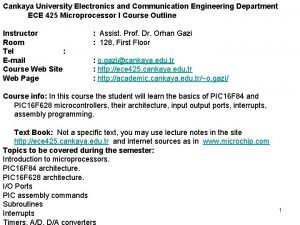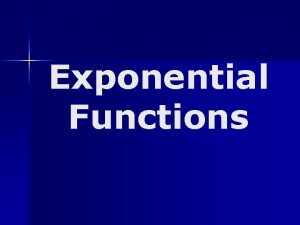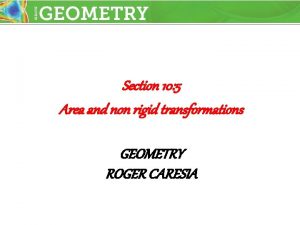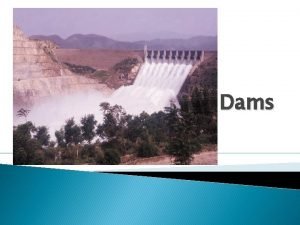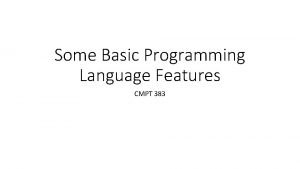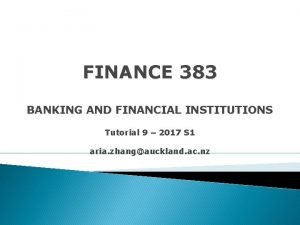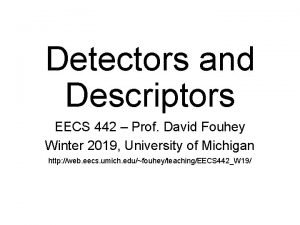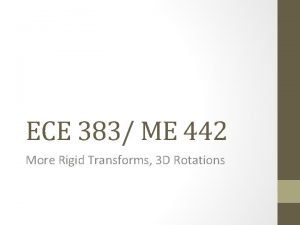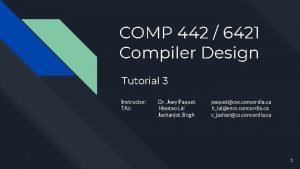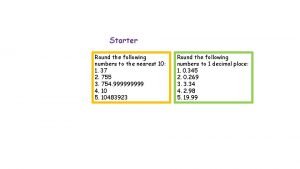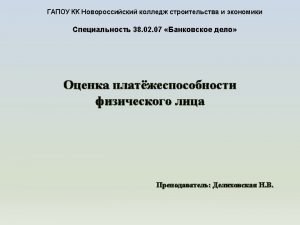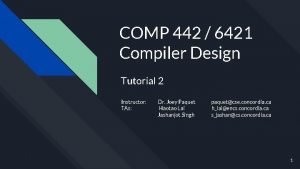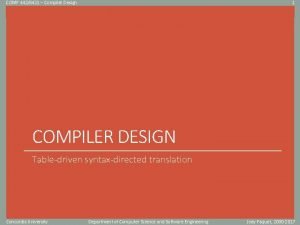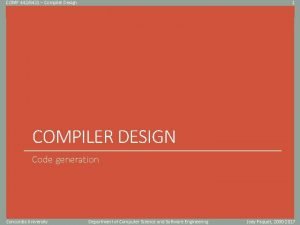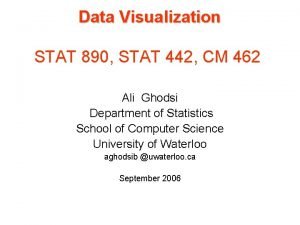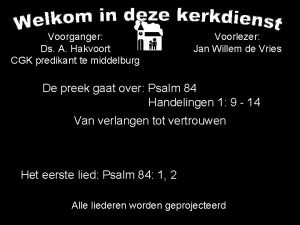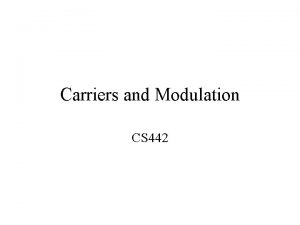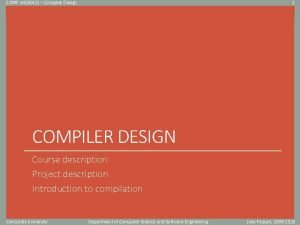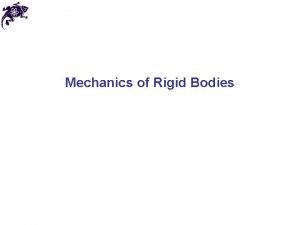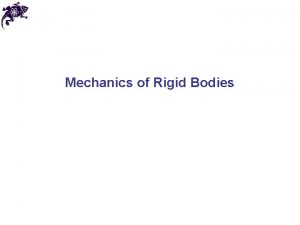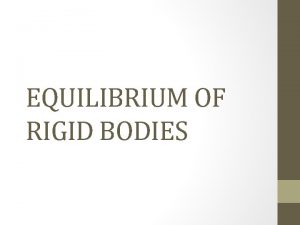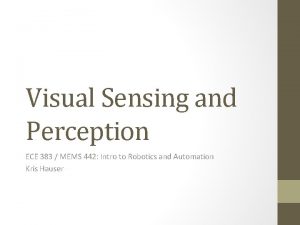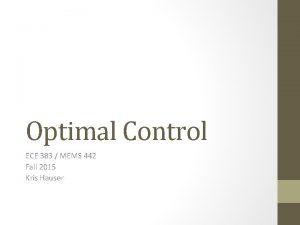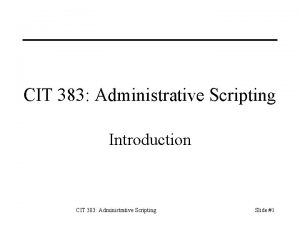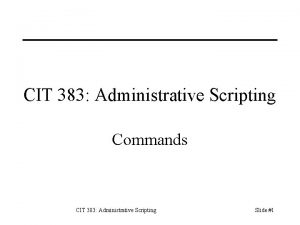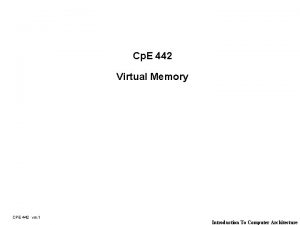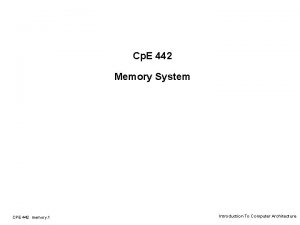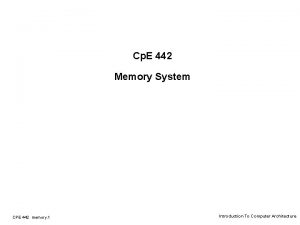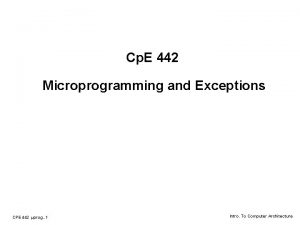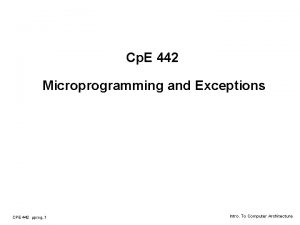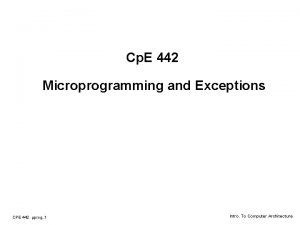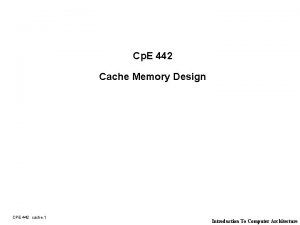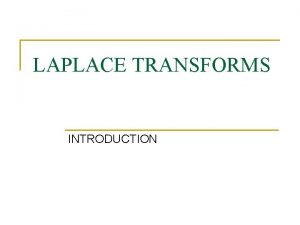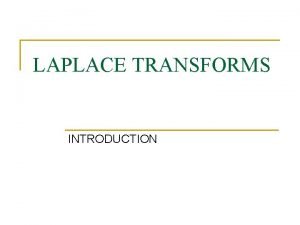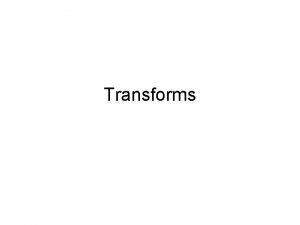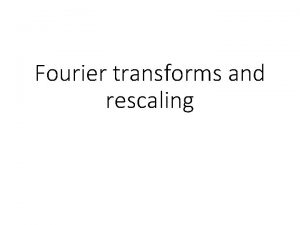ECE 383 ME 442 More Rigid Transforms 3
























![Summary • Rotation matrix • • • 9 parameters rij in range [-1, 1] Summary • Rotation matrix • • • 9 parameters rij in range [-1, 1]](https://slidetodoc.com/presentation_image_h/3058ba9b6d04a1c02e82c5b3808c3f73/image-25.jpg)







- Slides: 32

ECE 383/ ME 442 More Rigid Transforms, 3 D Rotations

Agenda • Working with transforms • 3 D rotations and representations

Operations on Transforms • Application • Composition • Inversion Accomplish: changes of coordinate frame • Interpolation • Differentiation Accomplish: movement

Composing 2 D transformations •

Rigid Transformation in 3 D • q = (R, tx, ty, tz) with R a 3 x 3 rotation matrix • Robot R 0 R 3 given in reference frame T 0 • What’s the new robot Rq? {Tq(x, y, z) | (x, y, z) R 0} • Define rigid transformation Tq(x, y, z) : R 3 Tq(x, y, z) = R 3 D rotation matrix x y z + tx ty tz Affine translation

3 -D Rigid Rotations r 11 r 12 r 13 r 21 r 22 r 23 r 31 r 32 r 33 (Right-handed coordinate system) n n det(A) = +1 Orthogonal rows and columns: ATA=I, AAT=I ||Ax|| = ||x|| for any x, L 2 norm ||. || Product of two rotations is a rotation (0, 1, 0) (r 11, r 21, r 31) (1, 0, 0) (0, 0, 1) (r 13, r 23, r 33) (1, 0, 0) (0, 0, 1) (r 12, r 22, r 32)

Coordinate Frames World frame Local frame (0, 1, 0) R (1, 0, 0) (0, 0, 1) R-1 = RT

Composing 3 D transformations •

Interpolating 2 D rotations • Naïve blend Geodesic blend: pick minimum of CW and CCW displacement

Topological spaces •

Some Important Topological Spaces • • • R: real number line Rn: N-dimensional Cartesian space S 1: boundary of circle in 2 D S 2: surface of sphere in 3 D SO(2), SO(3): set of 2 D, 3 D orientations (special orthogonal group) SE(2), SE(3): set of rigid 2 D, 3 D transformations (special Euclidean group) • Cartesian product A x B, power notation An = A x A … x A • Homeomorphism ~ denotes topological equivalence • • Continuous mapping with continuous inverse (bijective) Cube ~ S 2 SO(2) ~ S 1 SE(3) ~ SO(3) x R 3

Topology of SO(3) r 11 r 12 r 13 r 21 r 22 r 23 r 31 r 32 r 33 n n n 9 entries, constrained by: Orthogonal rows and columns: ATA=I, AAT=I det(A) = +1 n (+/- 1 is implied by the first condition) 9 variables - 6 non-redundant constraints => SO(3) has 3 degrees of freedom

4 representations of 3 D rotations • • • 3 x 3 rotation matrix R Euler angles REuler(f, q, y) Axis angle RAA(v, q) Quaternion RQuat(q) All representations are “equivalent” but may have certain mathematical or computational advantages

Axis-aligned rotations Rotate about: Z axis cos θ -sin θ 0 sin θ cos θ 0 0 0 1 Y axis cos θ 0 sin θ 0 1 0 -sin θ 0 cos θ X axis 1 0 0 0 cos θ -sin θ 0 sin θ cos θ

Parameterization of SO(3) § Euler angles: (f, q, y) z z y f 1 2 3 4 y q y x x x y

Euler Angles § § Which axes to pick, and what order? Convention A, B, C REuler(f, q, y) = RA(f)RB(q)RC(y) E. g. , ZYZ, ZYX (roll-pitch-yaw), etc

Euler Angles § Which axes to pick, and what order? § Convention A, B, C § REuler(f, q, y) = RA(f)RB(q)RC(y) § E. g. , ZYZ, ZYX (roll-pitch-yaw), etc § Disadvantages § Must constrain to range of values § Singularities, e. g. ZYZ when q=0 or p (Gimbal lock) § Interpolation?

Axis-Angle Representation • Every rotation matrix R can be obtained by rotating the identity matrix by some angle θ about some axis v! • R v = v

Axis-Angle Representation • Axis v (||v||=1), angle θ • Rodrigues’ formula: rotate x about v -> x’ x’ = x cos θ + (v x x) sin θ + v (v. T x) (1 - cos θ) Or in matrix form… RAA(θ, v) = cos θ I + sin θ [v] + (1 - cos θ) v v. T Cross product matrix 0 -vz vy vz 0 -vx -vy vx 0

Recovering Axis and Angle from the Rotation Matrix • θ = Angle(R) = cos-1((r 11+r 22+r 33 -1)/2) = cos-1((tr(R)-1)/2) • v = Axis(R) = 1/(2 sin θ) r 32 -r 23 r 13 -r 31 r 21 -r 12

Properties of Axis-Angle • Disadvantages: • Non unique: RAA(θ, v)=RAA(-θ, -v) (can constrain θ to range [0, p]) • 4 parameters + one unit length constraint ||v||=1; dealing with this constraint is sometimes annoying, for example, in interpolation, optimization, or sampling • Unique encoding: vector w = θv • θ = ||w||, v = w/||w|| • “Exponential map” REM(w) = RAA( ||w|| , w/||w|| )

Quaternion representation • Generalization of complex numbers • Complex z=z 0+i z 1, with |z|=1 can represent a 2 D rotation. What’s the 3 D analogue? q = q 0+q 1 i + q 2 j +q 3 k, where i 2 = j 2 = k 2 = -1 i = jk = -kj j = ki = -ik k = ij = -ji Quaternions were a forerunner of vectors and were once mandatory of all students of physics and math!

Unit quaternion representation • q = (q 0, q 1, q 2, q 3), ||q||=1 RQ(q) = 2(q 02+q 12)-1 2(q 1 q 2+q 0 q 3) 2(q 1 q 3 -q 0 q 2) 2(q 1 q 2 -q 0 q 3) 2(q 02+q 22)-1 2(q 2 q 3+q 0 q 1) • Related to axis angle: • q = (cos q/2, vx sin q/2, vy sin q/2, vz sin q/2) 2(q 1 q 3+q 0 q 2) 2(q 2 q 3 -q 0 q 1) 2(q 02+q 32)-1

Properties of Unit Quaternions • 4 -sphere: 3 D manifold in 4 D space • Non-unique: Double cover of SO(3) • Advantages (widely used in computer animation): • Quaternion multiplication = rotation composition (slightly faster than matrix *) • Curve interpolation formulas (Shoemake, ‘ 85)
![Summary Rotation matrix 9 parameters rij in range 1 1 Summary • Rotation matrix • • • 9 parameters rij in range [-1, 1]](https://slidetodoc.com/presentation_image_h/3058ba9b6d04a1c02e82c5b3808c3f73/image-25.jpg)
Summary • Rotation matrix • • • 9 parameters rij in range [-1, 1] Constraint: determinant +1 Advantages: composition, inversion are easy • Euler angles • • 3 parameters (f, q, y) in range [0, 2 p) Axes picked by convention (e. g. , Roll-Pitch-Yaw) Advantages: no constraints, simple interpolation “works” Disadvantages: multiple representation, singularities, composition & inversion not easy • Axis-angle • • 4 parameters (q, v), q in [0, p] Constraint: |v|=1 Advantages: intuitive, inversion is easy Disadvantages: constraint, composition & interpolation not easy , multiple representation at p • Moment representation (aka exponential map) • • • 3 parameters w (= q*v), ||w||<=p Advantages: no constraints, inversion easy, relation to angular velocity (as we shall see soon) Disadvantages: composition & interpolation not easy, multiple representation at p • Quaternion • • 4 parameters q=(q 0, q 1, q 2, q 3) Constraint: |q|=1 Advantages: composition & interpolation formulas, inversion easy Disadvantages: constraint, multiple representation R(q) = R(-q)

Notion of Distance • θ(R 1 TR 2) = cos-1 ((tr(R 1 TR 2)-1)/2) measures the minimum angle needed to rotate from frame R 1 to R 2 • Makes a good distance metric

Rotation in Motion • • Interpolating between two rotation matrices A and B We want a path X(s) : [0, 1] -> SO(3) with R(0) = A and R(1) = B Let v = Axis(ATB), θ = Angle(ATB) Verify that X(s) = A RAA(sθ, v) satisfies the desired properties Actually a geodesic in SO(3)!

Differentiating 2 D rotations •

Angular Velocities in 2 D •

Angular Velocities in 3 D • For parameterized rotation trajectory REM(wt), we can show: d/dt REM(wt) = [w] REM(wt) • => |w| is the speed of rotation • [w] is the cross product matrix • => w x x is the velocity of some point x, specified in world coordinates, attached to the frame as it rotates • => w is the angular velocity

Recap • 5 operations on transforms: • • • Application to points / directions Composition Inversion Interpolation Differentiation • Four common representations of SO(3) • All four implemented robustly in Python klampt. so 3 module, C++ in Kris. Library/math 3 d • Notion of distance, geodesic, velocity in SO(3)

Next Week • Lab: Intro to Python and Klamp’t
 More more more i want more more more more we praise you
More more more i want more more more more we praise you More more more i want more more more more we praise you
More more more i want more more more more we praise you Ece 442
Ece 442 Ece 442
Ece 442 Ece 442
Ece 442 Ece 442
Ece 442 Electronics q
Electronics q Ece 442 çankaya
Ece 442 çankaya Irrational function graph
Irrational function graph 10-5 area and nonrigid transformations
10-5 area and nonrigid transformations Non overflow dam
Non overflow dam Cmpt383
Cmpt383 Ieee-383
Ieee-383 Finance 383
Finance 383 Eecs 442
Eecs 442 Eecs 442
Eecs 442 Me 442
Me 442 Compiler design tutorial
Compiler design tutorial Fouhey
Fouhey 443 to the nearest 10
443 to the nearest 10 Ee 442
Ee 442 Eecs 442
Eecs 442 Me 442
Me 442 Compiler design tutorial
Compiler design tutorial Smart table 442i
Smart table 442i Compiler
Compiler Comp 442
Comp 442 Stat 442
Stat 442 Cgk middelburg
Cgk middelburg Sb 442
Sb 442 Cs 442
Cs 442 Controlece
Controlece Comp 442
Comp 442


